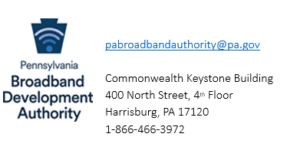
The Multi-Purpose Community Facilities program grants — approved for 49 projects in 26 counties — will give people free, digital access in public places like schools, local libraries, and community health centers.
The Pennsylvania Broadband Development Authority (PBDA) Executive Director Brandon Carson announced the approval of $45 million in Multi-Purpose Community Facilities grant funding to 49 projects in 26 counties across Pennsylvania. This funding will support key projects in local communities and help connect Pennsylvanians to the internet at places like a primary care health center in Allegheny County, affordable housing in Delaware County, and a public library in Northumberland County.
The PBDA Board of Directors approved the grants to eligible entities with public-facing facilities such as schools, local libraries, and community health centers to make improvements that will ensure people have free access to reliable, high-speed internet.
Today’s approval of the Multi-Purpose Community Facilities grants will help ensure that Pennsylvanians can access the resources they need to further their education, advance career opportunities, and utilize telemedicine options no matter where they live.
“Pennsylvania is leading the way when it comes to driving out these federal dollars to ensure more people have access to the internet. By expanding access to affordable, high-speed internet to every Pennsylvanian, we can create real opportunities for our students, our businesses, and our communities to learn, grow, and thrive,” said Governor Josh Shapiro. “Thanks to this historic investment from the federal government, my Administration has the resources to work with our community partners across the Commonwealth to bring reliable internet at high speeds and for affordable prices to every corner and every community in Pennsylvania — and we’ll continue to do that work effectively and efficiently.”
“Investing in public facilities improvements is an essential step in ensuring Pennsylvanians have access to reliable, high-speed internet across the Commonwealth,” said Executive Director Carson. “Public places like our libraries, health centers, and non-profit organizations are the fabric of our communities and this funding will help them better serve Pennsylvanians.”
The Multi-Purpose Community Facilities program was established by the PBDA utilizing a portion of the $279 million in Capital Projects Funds (CPF) awarded to Pennsylvania in June 2022 under the American Rescue Plan Act.
Eligible applicants for funding included, but weren’t limited to, schools, libraries, recreation centers, community health centers, non-profit organizations, municipalities, and local government institutions. The program requires projects be for construction or improvements to full-service community buildings, structures, and public spaces that directly enable work, education, and health monitoring. The physical structure must also be available year-round to the public.
A complete listing of the grants approved by the PBDA Board of Directors can be found here and includes:
$2,000,000 to Primary Care Health Services Inc. in Pittsburgh, Allegheny County
The new 44,112-square-foot Wilford A. Payne Medical Center and office building will be constructed on a surface parking lot adjacent to the current facility. It will become the most significant anchor for the redevelopment of the Homewood community — accommodating significant growth in patient services and providing publicly accessible internet.
$1,500,000 to the Chester Housing Authority in Chester County
The proposed project will launch a Chester e-Health Center to address the health disparities of seniors, lack of access to technology for employment and healthcare, improve access to e-learning training and job boards which are barriers to success for residents in the City of Chester.
$1,617,435 to Fox Township in Elk County
The township is planning to construct a History and Humanities Center to serve Fox Township and surrounding communities. The center will feature, among other things, a public cybercafe and Wi-Fi Hot spot for the public.
$522,205 to Allentown School District in Lehigh County
The Family and Community Engagement & Welcome Center project involves providing a 3,650-square-foot area for central registration for Allentown School District students and families. The space will accommodate activities aimed at creating a fast and easy registration process where students are directly connected to the services they need, including workforce and health monitoring for the public.
$379,000 to the Ralpho Township Public Library in Northumberland County
This project entails the renovation and adaptation of community space within the library. The space will be equipped with amenities such as public computers and privacy pods to support the public’s ability to engage in internet enabled workforce, education, and health monitoring activities.
$787,323 to Liberty Township in Susquehanna County
This project involves the rehabilitation of a public venue, Grange Hall, to enable Liberty Township to establish a centralized hub for the community and address the public’s critical need for broadband access to essential services.
“The Biden-Harris Administration is making progress across the country to ensure Americans have access to affordable high-speed internet,” said U.S. Deputy of the Treasury Wally Adeyemo. “With these investments in libraries and other community facilities, families in Pennsylvania will gain access to critical services like health care and education.”
In addition to approving the Multi-Purpose Community Facilities funding, under the Shapiro Administration the PBDA has also:
- Announced in March 2024 that Pennsylvania secured a$20 million federal investment to provide laptops for distribution to schools, libraries, municipalities, workforce training organizations, and other non-profits who can make them available to individuals that lack the technology needed to access the internet through American Rescue Plan Capital Projects Funding. On June 18, 2024, the PBDA announced it was accepting applications for the funding.
- Governor Shapiro and Executive Director Carson announced in June 2023 the Commonwealth will receive more than$1.16 billion in federal funding to expand broadband in unserved and underserved areas to make sure every Pennsylvanian has access to affordable, high-speed internet. The funding is coming to Pennsylvania through the federal BEAD Program and is part of President Biden’s “Internet for All” initiative.
- The Shapiro Administration is also investing $204 million in funding through the Capital Projects Fund Broadband Infrastructure Program to connect unserved and underserved areas.
Visit the Pennsylvania Broadband Development Authority’s website to learn more about its work to close the digital divide in the Commonwealth.



